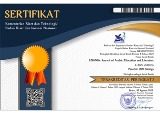Improving Students’ Motivation and Psychology in Speaking Arabic through Dubbing Japanese Anime to Arabic
Abstract
This article aims to determine the level of motivation and to build students' interest in speaking Arabic with Japanese to Arabic anime voiceover media, as well as to overcome students' psychological problems. A total of 90 students aged 15-18 years in three educational institutions in Java Island participated in the study. The data were calculated quantitatively descriptively, processed by the Kolmogorov normality test using SPSS 26 and made and analyzed a comparison table of pretest and posttest scores from the HARS (Hamilton Anxiety Rating Scale) questionnaire. The results confirmed that there was a significant change in the results of the HARS questionnaire table and the Kolmogorov value with a mean value of 44.04 which was greater than the hypothesis, which was 30.00. The implications of this research can be used as an alternative learning media in increasing motivation and overcoming students' negative psychology in learning Arabic in Indonesia.
Keywords
Full Text:
PDFReferences
Affandi, I. (2015). Strengthening National Identity: Learning from the Performance and Culture of the Japanese Nation. Pearl Press Bandung.
Ameri, S. (2020). Dubbing viewers in cyberspaces: A netnographic investigation of the attitudes of a Persian-language online community. KOME, 8(1), 23–43. https://doi.org/10.17646/KOME.75672.45
Ávila-Cabrera, JJ (2022). Improving Oral Production Skills in the Business English Class Through Creative Dubbing. ESP Today, 10(1), 99–122. https://doi.org/10.18485/ESPTODAY.2022.10.1.5
Azwar, S. (2013). Preparation of the Psychological Scale. Learning Library, Yogyakarta.
Bautista Ortuño, R., Bonete-López, B., & Lorente-Martínez, R. (2021). Festival of audiovisual micro-stories in psychology (Microfest): An innovative teaching project for students of audiovisual communication and journalism. Administrative Sciences, 11(4). https://doi.org/10.3390/admsci11040120
Bradley, MM, Codispoti, M., Cuthbert, BN, & Lang, PJ (2001). Emotion and Motivation I: Defensive and Appetitive Reactions in Picture Processing. Emotions, 1(3), 276–298. https://doi.org/10.1037/1528-3542.1.3.276
Chiaro, D. (2009). “Issues in Audiovisual Translation.” Routledge. New York, In The Routledge Companion to Translation Studies, 141–165.
Díaz-Cintas, J. (2019). Film censorship in Franco's Spain: the transforming power of dubbing. Perspectives: Studies in Translation Theory and Practice, 27(2), 182–200. https://doi.org/10.1080/0907676X.2017.1420669
Donzuso, G., Cerasa, A., Gioia, MC, Caracciolo, M., & Quattrone, A. (2014). The neuroanatomical correlates of anxiety in a healthy population: Differences between the state-trait anxiety inventory and the Hamilton anxiety rating scale. Brain and Behavior, 4(4), 504–514. https://doi.org/10.1002/brb3.232
Dörnyei, Z. (2005). The Psychology of The Language Learner: Individual Differences in Second Language Acquisition. Erlbaum.
Dörnyei, Z. (2020). Innovations and Challenges in Language Learning Motivation. Routledge. New York.
Eccles, JS, & Wigfield, A. (2002). Motivational beliefs, values, and goals. Annual Review of Psychology,. 53, 109–132.
Fernández-Costales, A. (2021). Subtitling and dubbing as teaching resources in clil in primary education: The teachers' perspective. Porta Linguarum, 2021(36), 175–192. https://doi.org/10.30827/portalin.v0i36.16228
Fuentes, B., & de la Fuente-Gómez. (2022). Dubbing Language-therapy Cinema-based in Aphasia post-Stroke (DULCINEA): Study protocol for a randomized crossover pilot trial. Trials, 23(1), 1–8. https://doi.org/10.1186/s13063-021-05956-5
González, LP (2016). Audiovisual Translation.”. In Routledge Encyclopedia of Translation Studies., 4(1), 1–23.
Green, T. (2019). “Dubbing” precolonial Africa and the Atlantic diaspora: Historical knowledge and the Global South. Atlantic Studies Global Currents , 0(0), 1–15. https://doi.org/10.1080/14788810.2018.1550891
Hatami, W. (2020). Japanese Anime as a PKN Learning Resource. Edueksos Journal, IX(2), 52–66.
Huang, J. (2022). A Case Probe into Emotional Experiences of Chinese English Majors in L2 Listening Learning Process: A Positive Psychology Perspective. SAGE Open, 12(1), 215824402210798. https://doi.org/10.1177/21582440221079815
Iturregui-Gallardo, G., & Matamala, A. (2019). Audio subtitling: dubbing and voice-over effects and their impact on user experience. Perspectives: Studies in Translation Theory and Practice, 0(0), 1–20. https://doi.org/10.1080/0907676X.2019.1702065
Jaya, PH (2016). Analysis of Translation Errors in Voiceover from English to Indonesian (Case Study on Spongebob Squarepants Cartoon Series on Global TV). (Doctoral Dissertation, Gadjah Mada University).
Kirillova, K., Peng, C., & Chen, H. (2019). Anime consumer motivation for anime tourism and how to harness it. Journal of Travel and Tourism Marketing, 36(2), 268–281. https://doi.org/10.1080/10548408.2018.1527274
Kusumasturi, F. (2011). Contrastive analysis of subtitling and dubbing in the Dora the Explorer cartoon series Wish Upon a Star: Study of translation techniques and translation quality.
Palumbo, G. (2009). Key Terms in Translation Studies. Continuum International Publishing Group. London.
Pamungkas, FD (2019). IMPROVING STUDENTS PRONUNCIATION USING VIDEO DUBBING (A Classroom Action Research for Tenth Grade and Eleventh Grade Students of Vocational High School). American Journal of Psychology, 7(1), 11–17. https://doi.org/10.33603/PERSPECTIVE.V7I1.1794
Pekrun, R., Goetz, T., & Perry, RP (2005). Academic emotions questionnaire (AEQ). User's manual. Department of Psychology, University of Munich.
Pujihastuti, I. (2010). "Principles of writing a research questionnaire." Journal of Agribusiness and Regional Development 2.1, 43–56.
Qasim, A., & Yahiaoui, R. (2019). The Role of Subtitling and Dubbing in Arabic Vocabulary Acquisition: A Contrastive Study. SSRN Electronic Journal, May. https://doi.org/10.2139/ssrn.3337241
Roromari, MR (2016). The Effectiveness of Using Subtitles and Dubbing in Films on the Level of Understanding of Children's Stories. (Experimental Study on the Effectiveness of Using Indonesian Subtitles and Indonesian Dubbing in the Film “The Boy Who Cried Wolf.”
Ruqaiyah, Abdullah, N., Hatta, M., Mappeware, NA, Harun, A., Amir, F., & Baharuddin, A. (2020). Anxiety level assessment for primigravidae women (28-40 weeks) with Hamilton anxiety rating scale (HARS) method. Indian Journal of Forensic Medicine and Toxicology, 14(4), 3412–3417. https://doi.org/10.37506/ijfmt.v14i4.12153
Saeful Bahri. (2020). THE RELATIONSHIP BETWEEN PSYCHOLOGICAL CHARACTER AND ACHIEVEMENT MOTIVATION WITH STUDENTS' LEARNING ACHIEVEMENT IN ISLAMIC RELIGIOUS EDUCATION SUBJECTS.
Schutz, PA, & Lanehart, SL (2002). Introduction: Emotions in education. Educational Psychologist.
Soler, B. (2020). Subtitling and dubbing as a teaching resource for learning English as a foreign language using the Clipflair software. University, Spanish Pardo, Valencia, 41–56.
Spieler, C., & Miltenberger, R. (2017). Using awareness training to reduce nervous habits during public speaking. Journal of Applied Behavior Analysis, 50(1), 38–47. https://doi.org/10.1002/jaba.362
Sugarman, MA, Loree, AM, Baltes, BB, Grekin, ER, & Kirsch, I. (2014). The efficacy of paroxetine and placebo in treating anxiety and depression: A meta-analysis of change on the Hamilton Rating Scales. PLoS ONE, 9(8). https://doi.org/10.1371/journal.pone.0106337
Sugiyono. (2012). Quantitative Qualitative Educational Research Methods and R & D. Alfabeta, Bandung.
Tauba, M. (2019). Maharah and Kafa'ah in Learning Arabic. Arabic Studies, 10(1), 31–38. https://doi.org/10.35891/sa.v10i1.1765
Ummatin. K. (2017). Analysis of the results of the translation of the term Culture Sound in Surabaya Cinemas. (Doctoral Dissertation, Airlangga University).
Vatanartiran, Ö. (2020). Dubbing as a creative industry in Turkey. In Creative Industries in Turkey (pp. 181–191). https://api.elsevier.com/content/abstract/scopus_id/85113503621
Yahiaoui, R. (2021). The Impact of Image on Translation Decision-Making in Dubbing into Arabic - Premeditated Manipulation par Excellence: The Exodus Song as a Case Study. Open Cultural Studies, 5(1), 66–80. https://doi.org/10.1515/culture-2021-0004
Zhang, L., Ji, Y., Lin, X., & Liu, C. (2018). Style transfer for anime sketches with enhanced residual u-net and auxiliary classifier GAN. Proceedings - 4th Asian Conference on Pattern Recognition, ACPR 2017, 512–517. https://doi.org/10.1109
DOI: https://doi.org/10.18326/lisania.v6i2.126-138
Refbacks
- There are currently no refbacks.
Copyright (c) 2022 Taufik Nurrohman, Nurul Fikriyah

This work is licensed under a Creative Commons Attribution-ShareAlike 4.0 International License.
View My Stats







